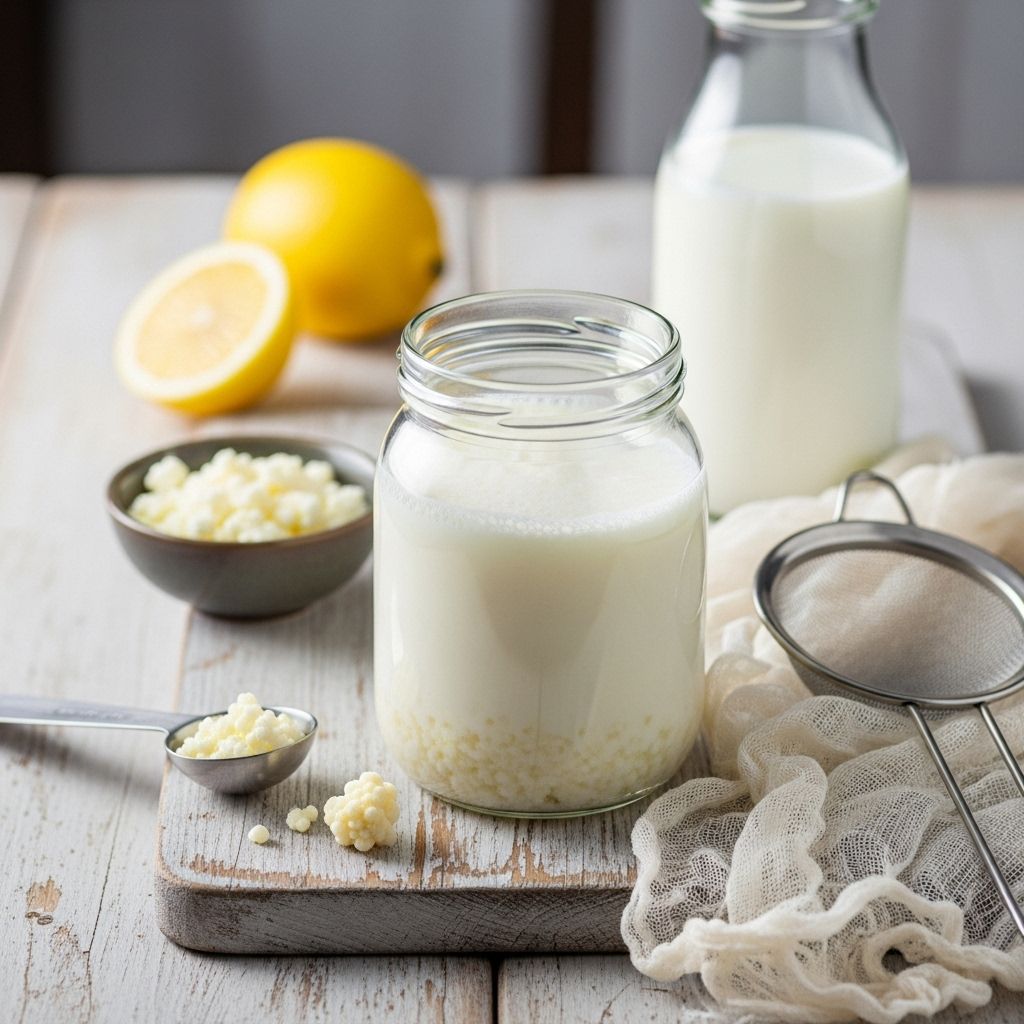How to Make Milk Kefir at Home: Guide to Healthier Fermented Dairy
Transform dairy into a tangy, nutrient-rich elixir that supports balanced digestion.

How to Make Milk Kefir at Home
Milk kefir is a fermented dairy drink known for its tangy flavor, unique effervescence, and remarkable health benefits. Producing kefir at home is straightforward, economical, and allows you to control the fermentation process for your preferred taste and consistency. This guide will walk you through everything you need to know about making milk kefir from scratch, including the tools required, step-by-step instructions, health benefits, common issues, and expert tips.
What is Milk Kefir?
Milk kefir is a cultured, probiotic-rich beverage made by fermenting milk with kefir grains—a combination of bacteria and yeasts embedded in a matrix of proteins, lipids, and sugars. The process creates a tangy, creamy drink full of beneficial microorganisms. Unlike yogurt, which is fermented with heat and specific cultures, kefir ferments at room temperature with broader microbial diversity. Its roots trace back to the Caucasus Mountains and have since been embraced worldwide for digestive and immune-boosting properties.
Milk Kefir vs. Yogurt
| Feature | Milk Kefir | Yogurt |
|---|---|---|
| Fermentation Temperature | Room temp (65–80°F, 18–27°C) | Warm (110°F, 43°C) |
| Starter Culture | Kefir grains (bacteria + yeasts) | Thermophilic bacteria |
| Probiotic Diversity | Broad (up to 61 strains) | Fewer strains (1–5 varieties) |
| Texture | Thin, pourable | Thicker, spoonable |
| Taste | Tangy, slightly sour, fizzy | Tart, creamy |
Supplies and Ingredients Needed
- Kefir grains: Live grains are essential as the starter culture. They look gelatinous and resemble tiny cauliflower pieces.
- Milk: Any unflavored dairy milk works—whole, 2%, or skim from cows, goats, or sheep. Ultra-pasteurized milk may result in inconsistent fermentation, so regular pasteurized or raw milk is preferred.
- Clean glass jar: One-pint to one-quart size works well for small batches.
- Non-metal strainer: To separate the grains from the finished kefir (stainless steel is generally safe, but many prefer plastic, silicone, or nylon).
- Non-metal stirring utensil: A wooden or plastic spoon avoids potential reactions with the grains.
- Coffee filter or breathable cloth: To cover the jar and keep dust or insects out without sealing it airtight.
- Rubber band: To secure the cloth or filter over the jar.
Step-by-Step: How to Make Milk Kefir
- Add kefir grains to the jar:
Use about 1 to 2 teaspoons of kefir grains for every 2 cups (480ml) of milk. Place the grains in the clean glass jar. - Add the milk:
Pour fresh milk into the jar with the grains. Use higher-fat milk for a creamier kefir, but any milk, except ultra-high temperature, will culture successfully. - Cover and secure:
Place a coffee filter or breathable cloth over the mouth of the jar and secure it with a rubber band. Do not seal with a tight lid—air needs to escape during fermentation. - Ferment at room temperature:
Let the jar sit at room temperature, away from direct sunlight or heat, for 12 to 36 hours. Fermentation time depends on ambient temperature and how tangy or thick you want your kefir—shorter times for milder kefir, longer for thicker and tangier. - Check for readiness:
After 12 hours, gently swirl the jar. Finished kefir will appear slightly thickened and have a tart, pleasantly sour smell. You may see some mild separation (curds and whey), which is normal. If you notice excessive separation, the kefir is likely very tangy and ready to strain. - Strain the kefir:
With clean hands, place a non-metal strainer over a bowl or clean jar. Pour the kefir liquid through, using a spoon to gently stir and help the liquid flow through while retaining the grains in the strainer. - Store the finished kefir:
Transfer strained liquid into a jar with a lid. Refrigerate immediately—cold slows fermentation and preserves freshness. Consume within one to two weeks. - Re-use the grains:
Return the grains to a fresh jar with more milk. Repeat the process to make endless batches of milk kefir.
Tips for Consistency and Flavor
- Ferment time: Longer fermentation yields tangier, thicker kefir, but can cause excessive separation. Taste every few hours after 12 hours to determine your preference.
- Amount of grains: Too many grains will speed up fermentation and create a strong, less palatable drink. Stick to 1 to 2 teaspoons per 2 cups milk.
- Strainer material: While stainless steel is generally safe, prolonged exposure to metal can damage the grains over time.
- Jar cleaning: Wash and rinse fermentation jars thoroughly between batches for clean, healthy grains.
- Reuse: Kefir grains can be reused indefinitely if cared for properly—rinse gently only if needed.
How to Flavor and Enjoy Milk Kefir
- Drink plain: Shake well and pour straight from the fridge for the freshest, tangiest kefir experience.
- Fruit blends: Add fresh fruit, berries, or a tablespoon of fruit preserves to sweeten and enhance flavor.
- Honey or maple syrup: Stir in a teaspoon of natural sweetener for extra appeal.
- Smoothies: Use kefir as a base in smoothies for a probiotic boost.
- Second fermentation: After straining, store kefir with added fruit or herbs (ginger, lemon peel) at room temperature for 12–24 hours before refrigerating. This enriches flavor and increases carbonated effervescence.
Health Benefits of Milk Kefir
Milk kefir is often called a superfood for its combination of essential nutrients and broad probiotic diversity. Not only does it provide the building blocks for a healthy diet, but fermentation also unlocks unique properties not present in unfermented milk. According to clinical research and nutrition experts, the key benefits include:
- Digestive health: Probiotic bacteria (such as Lactobacillus and Bifidobacterium species) help maintain gut balance, improve digestion, and may ease symptoms of IBS, diarrhea, and lactose intolerance. Kefir’s yeasts contribute enzymes that further break down milk sugars.
- Immune support: Active cultures stimulate immune function and help neutralize harmful microorganisms. Some studies suggest kefir may support resistance against infections.
- Bone health: Dairy-based kefir is packed with calcium, vitamin D, vitamin K2, phosphorus, and magnesium—nutrients linked to bone density and reduced osteoporosis risk as you age.
- Cardiovascular support: Regular kefir consumption is associated with lower blood pressure, better cholesterol management, and improved heart health, though more research is needed to clarify mechanisms.
- Protein and micronutrients: Kefir provides high-quality protein and is rich in B vitamins (B1, B2, B5, and B12), essential amino acids, and antioxidants. These are vital for energy production, cellular health, and nervous system function.
- Ease of digestion: The fermentation process lowers lactose content by about 20–30%, making kefir easier to digest than regular milk, particularly for those with lactose sensitivity.
Nutritional Facts (per 1 cup, 245ml low-fat milk kefir):
- Calories: ~104–145
- Protein: 8–9g
- Fat: 2–7.5g (depends on milk)
- Carbohydrates: 11–12g
- Calcium: 333mg (about 33% of RDI)
- Magnesium: 28mg
- Potassium: 383mg
- Vitamin B12: 0.7mcg (almost 30% daily value)
- Vitamin D: Varies with milk fortification
- Probiotic strains: Up to 61 identified (varies by grains and milk type)
Troubleshooting: Common Issues and Fixes
- Kefir separates too fast (curds and whey): This can happen if the environment is too warm or the grain-to-milk ratio is too high. Reduce grains, ferment in a cooler spot, or reduce fermentation time to 12–18 hours.
- Kefir not thickening: Grains may be too few, inactive, or milk is ultra-high temperature processed. Ensure grains are active and use pasteurized or raw milk for best results. Sometimes, it may simply need more time.
- Off odors or colors: Kefir should smell pleasantly tangy or yeasty. Unusual odors (like cheese gone very sour or rotten) or discoloration (pink or orange hues) indicate contamination. Discard and start fresh with new grains.
- No fizz: Kefir typically has subtle carbonation. For more fizz, use airtight secondary fermentation for 12–18 hours with added fruit, then refrigerate.
- Missing grains after straining: Grains are small and can slip through coarse strainers. Use a finer mesh or carefully retrieve grains by hand.
How to Care for and Store Kefir Grains
- Regular use: Keep grains in fresh milk and repeat the fermentation cycle every 24–48 hours for best health and productivity.
- Short-term storage: Pause production by storing grains in a small jar with fresh milk in the refrigerator for up to two weeks. Change milk every 7–10 days.
- Long-term storage: Rinse grains gently and freeze them in a small amount of milk, or dry grains and store in the freezer for several months.
- Revival: After storage, grains may need a few batches to return to peak fermentation activity.
Variations and Dairy-Free Alternatives
- Non-dairy milks: While traditional kefir uses dairy, you can cultivate grains in coconut milk, almond milk, or soy milk. However, grains need to be refreshed in dairy milk regularly to stay viable and multiply.
- Flavored milks: Use unsweetened, additive-free varieties for best results; sugar and thickeners can inhibit healthy fermentation.
Safety & Best Practices
- Always use clean hands and utensils to avoid unwanted microbes entering your kefir culture.
- Check for consistent, pleasant aromas before consuming each batch.
- If you or your household members are immune-compromised, consult a healthcare professional before making or drinking fermented foods at home.
Frequently Asked Questions (FAQs)
Q: Is milk kefir safe for lactose intolerant individuals?
A: Yes, the fermentation process breaks down much of the lactose present in milk. Most people with lactose intolerance can tolerate kefir, though sensitivity levels differ by individual.
Q: Can I make kefir with raw milk?
A: Yes, raw milk can be used and will produce a slightly richer flavor. Ensure the milk is from a reputable, clean source. Note that fermentation with raw milk may introduce extra wild microbes, requiring more careful monitoring.
Q: What should I do if my kefir tastes too sour?
A: Reduce fermentation time or the amount of kefir grains. You can also try fermenting in a cooler area of your kitchen.
Q: What are the best containers for fermenting kefir?
A: Appropriate containers are non-reactive, such as glass, food-grade plastic, or ceramic. Avoid prolonged contact with metal.
Q: How do I increase carbonation?
A: Use a sealed container for a second fermentation with fruit or a bit of sugar to encourage natural bubbles, then refrigerate.
Conclusion
Homemade milk kefir is one of the easiest and most affordable ways to enjoy fermented, probiotic-rich dairy daily. With only two basic ingredients and a few common kitchen tools, you can experiment with flavor, tang, and texture for a beverage that matches your taste and health goals. The fermentation process may seem mysterious, but with these guidelines, even beginners can master milk kefir—nourishing themselves, their families, and their homemade food traditions.
References
- https://www.maplehill.com/post/what-is-kefir-its-health-benefits-history
- https://pmc.ncbi.nlm.nih.gov/articles/PMC7071183/
- https://www.bbcgoodfood.com/health/nutrition/health-benefits-kefir
- https://www.healthline.com/nutrition/9-health-benefits-of-kefir
- https://www.webmd.com/diet/kefir-good-for-you
- https://health.clevelandclinic.org/benefits-of-kefir
- https://zoe.com/learn/what-is-kefir
- https://www.rawmilkinstitute.org/updates/the-fascinating-history-of-milk-kefir
- https://pmc.ncbi.nlm.nih.gov/articles/PMC11011999/
Read full bio of Sneha Tete












